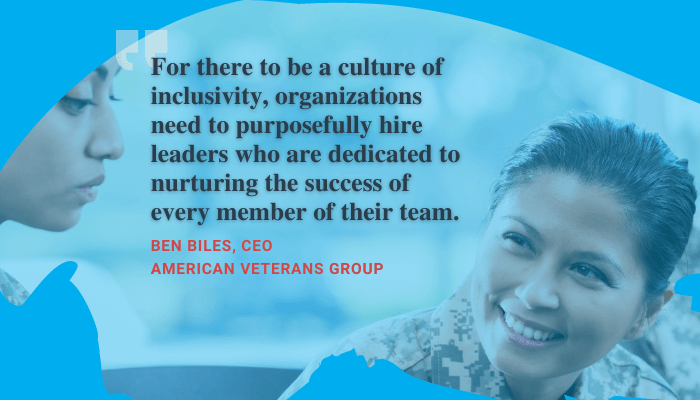
As his administration began, President Biden issued an executive order that outlined his administration’s vision for a federal workforce that reflects the country’s diversity.
This order directs government agencies to examine how their hiring, professional development, and employee retention practices promote and foster equity in the workplace. It prioritizes employment opportunities for historically marginalized groups and those who have faced employment barriers due to their background or identity.
Veterans and military spouses are recognized in the order, and for good reason. Beyond being circumstantially diverse by virtue of their employment,
veterans reflect the diverse makeup of the country on the whole. Though federal agencies and corporations have enthusiastically created
hiring programs specifically for veterans, veterans’ employment retention for their early post-service jobs is shockingly low. In fact, the
Harvard Business Review reports that 60-80% of veterans leave their first post-service position in less than two years.
Veterans have a strong work ethic and are committed to excellence. So why is it that so many of us struggle with the transition to a civilian workplace? While employers may be using their DE&I programs to hire a
diverse workforce, they seem to be falling short on using them to create an
inclusive workplace.
A
report from VetAdvisor and Syracuse University’s Institute for Veterans and Military Families indicates that the top reasons veterans leave their first civilian jobs include lack of advancement and professional development opportunities, unfamiliar work environment/culture, and feeling their civilian work lacks meaning. In short, employers are not implementing inclusive practices to retain their veteran hires.
So how can organizational leaders, managers and recruiters foster inclusivity for their veteran employees? Here are some DE&I best practices and how they can be implemented to specifically improve veteran retention and improve support in the civilian workspace.
- Think before you act - check your (organization’s) mindsets. Before inclusive practices can be enacted, you need to consider how diversity, equity and inclusion are talked about in your organization. Research conducted by Dr. Lisa Leslie, associate professor of management and organizations at the Stern School of Business, indicates that employees are more likely to support and put effort into diversity and inclusion initiatives if organizational leaders talk about both the importance and difficulties of working in a diverse environment. Leaders need to acknowledge the work may be hard but is critical in order to increase employee buy-in.
- It starts from the top – hire leaders who are dedicated to the success of everyone on the team. For there to be a culture of inclusivity, organizations need to purposefully hire leaders who are dedicated to nurturing the success of every member of their team. These leaders are responsible for modeling inclusive practices, establishing and maintaining support structures, and ensuring their employees have all the tools they need to succeed.
- For veterans, that might look like organizational leaders connecting newly hired veterans with a company mentor who has successfully undergone the transition to civilian employment and who can offer informed support and guidance.
- It’s a team effort – set habits of team-wide perspective taking. Establish protocols and operational structures that imbed opportunities for team members to share and take on different perspectives. Encourage individuals to partake in new experiences and explore novel ideas.
- For veterans, this may look like educating leaders and teams on aspects of military culture. Develop transitional resources for newly hired veterans that outline the organization’s structure, vocabulary, and norms. As a result, both veteran and non-veteran employees will be able to better understand their coworkers’ perspectives and working style.
- It’s bigger than you and me – set and center collective team goals. Set and center collective goal(s) that resonate with the team in order to encourage a collaborative and inclusive culture. Diverse teams may struggle when individual approaches, communication styles, or ways of thinking do not align; however, by emphasizing a clearly defined, and shared objective, teams can shift to a collaborative working model.
- For veterans, working toward a shared goal is nothing new. It’s important to clearly communicate and articulate the mission and purpose of their new civilian position. Define how their contributions support the collective objective set by their team so they’re able to find meaning in their work.
While I have outlined some of the DE&I best practices and how they can be used to support veteran retention, it is critical to remember that
veterans are not a monolith.
There are veterans of every color and creed whose difficulty with transitioning to civilian employment falls on a spectrum.
While these practices are not a catch-all, they’re a good first step toward increasing veteran retention by honoring the diversity, centering the equity, and emphasizing the inclusion of veterans in the workforce.


